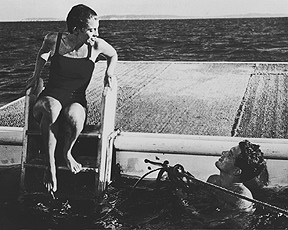
Bonjour Tristesse
Directed byOtto Preminger
Written by
Arthur Laurents
With
Deborah Kerr, David Niven, Jean Seberg, Geoffrey Horne, and Mylene
Demongeot.
Rating
* * * *
Masterpiece

| Bodies in Motion | ||
 |
Bonjour TristesseDirected byOtto Preminger Written by
With
Rating
|
|
| By Fred Camper | ||
Otto Preminger's 1958 Bonjour Tristesse — one of the masterworks of the period — used the relatively new format of CinemaScope to present its five characters in various tableaux. CinemaScope was often used with subjects almost absurdly well suited to the screen's shape: one of the first such pictures was a submarine movie. But Preminger uses it in this film to depict ambiguous, shifting relationships in a tale of conflicting obsessions. Unavailable in its original form for decades, the film has recently been restored and is being shown here once, on Thursday, September 30, at the Film Center.
Following fairly closely the Françoise
Sagan novel on which it's based, the film's principal action occurs
in summer in and around a villa on the French Riviera rented by wealthy
playboy Raymond (David Niven) for himself, his teenage daughter Cecile
(Jean Seberg), and his current mistress, Elsa (Mylene Demongeot). The father
and daughter are quite close, but the film avoids suggesting incestuous
desires, as does the book: Raymond and Cecile are bonded by their shared
enjoyment of laughter and silliness, partying, and gentle relaxing (one
morning they "smell the day" together). Cecile has become accustomed to
Raymond's steady stream of much younger mistresses, but then a longtime
family friend of about his age, accomplished fashion designer Anne Larsen
(Deborah Kerr), joins them at the villa. Elsa, feeling abandoned, departs
with an admirer named Pablo, and The novel, narrated by Cecile, is a social drama about a girl drawn
to superficial pleasures both because of her age and her father's example.
While some of Sagan's portrait survives in the film, Seberg too often recites
lines rather than inhabiting her role, and Niven's air of uninformed superficiality
seems more English than French. Like Sagan — who has Cecile tell the story
almost a year after it happened — Preminger begins and ends the film with
Cecile filmed in black and white in Paris reflecting in voice-over on her
isolation and sadness. By framing color scenes — and on occasion interrupting
them — with black-and-white scenes of the present, Preminger makes the
world of the seaside story seem more sensual and intense but also impermanent. Intercutting color with black-and-white footage is an obvious stylistic
device, and on the whole Preminger's style here is relatively transparent,
especially compared with such contemporaneous masterworks as Hitchcock's
Vertigo
and Welles' *** Preminger's style is subtle and restrained. But as in most great narrative
films, the camera here in effect reinvents the story, transforming Sagan's
first-person character study into a melancholy dance of personalities at
utter cross-purposes. These conflicts are inherent in the narrative: it's
obvious that Raymond will fail to match Anne's seriousness, just as Cecile
fails to match Philippe's commitment to her, yet Cecile and Raymond show
a greater self-awareness than Elsa. But what Preminger does is translate
the shifting relationships between these very different personalities into
carefully choreographed camera movements, which over time evolve into an
intensely expressive vision of ever-changing, ever expanding space.
Most of the film is made up of relatively long tableaulike takes, yet
Preminger often transforms static shots of conversations when a character
leaves the group. Following one character out of a scene had been a common
device in Hollywood filmmaking for decades, but Preminger uses it with
such systematic care — often without cutting — that it comes to represent
this world's underlying instability. When a group breaks up, his camera
follows their bodies, twisting first one way, then another. Eventually
the viewer sees every static composition as founded on shifting sand —
a momentary configuration of relationships and emotions that's bound to
change. This approach makes even the affectionate father-daughter bond
seem strangely impermanent — though of course the film's flashbacks also
reveal that their relationship has weakened. The camera alone allows us
to see that Anne's self-assurance will be no match for Raymond's and Cecile's
flighty emotions, not so much because of the kind of people they are as
because their sensual, sun-drenched world — represented by the ever present,
impossibly blue sea and seen through Preminger's profoundly ungrounded
camera — is ultimately opposed to monogamous affections. Raymond and Cecile's
bond survives only because each allows the other multiple romantic partners.
Fragmentation occurs in various ways in the film's key scenes. When
Raymond tells a lie to conceal his planned meeting with Elsa, he's one
of three people shown at lunch, but he soon wanders off into the background.
When Cecile has second thoughts and contemplates ending her scheme, she
stands against a wall to the right in a geometric image that shows Anne
seated in a window to the left, then suddenly rising and going outside,
where she appears on Cecile's right and moves into the foreground and then
walks away. Just before Raymond and Cecile see Philippe and Elsa lying
together literally at their feet, they take a twisting path through the
woods, which the camera records in a diverse mix of movements and positions,
finally filming them from slightly above. Eventually one starts to notice
small asymmetries even in the static shots — a slight high angle here,
a slight obliqueness there. These perspectives open up a gap between the
camera and the characters, implying that the composition we see is only
a momentary arrangement of bodies in a wider, freer space. Dancing together,
the camera and characters trace the lineaments of both fickleness and obsession,
of passing fancies and their dark consequences.
Ultimately the film's space — the mental construct created by
the composition of images over time — has two poles. Tight and entrapping
images consistently open up, suggesting a dialogue between imprisonment
and freedom — an idea also central to Cecile's effort to recover her carefree
life. At the same time the twisting camera movements and oblique angles
combine with the ever present sea to suggest a vaster universe than anything
visible in a single composition. The malleability of most of the images
indicates the characters' freedom to wander off. Yet the many different
directions they take suggest that their freedom leads to chaos and fragmentation,
each locked in a separate world, none in true contact with the others.
*** Preminger chooses to end Bonjour Tristesse — a film with few
close-ups, whose group shots reveal the enchantments and delusions of mostly
"silly" people — with his closest shot yet. We see a saddened Cecile in
a mirror applying cold cream to her face while contemplating in voice-over
the wall that her failed plotting has erected around her — thoughts affectingly
rendered by the empty space of the 'Scope frame surrounding her head. This
anomalous close-up provides the film's final moment of horror: Cecile's
isolation helps us realize that schemes based solely on one's own emotional
needs, even when designed to bind you closer to another, will leave you
utterly alone in the end.
Subscription
and general information about the Reader.

On Film Main
Screen | Now
Showing | Showtimes
| Brief Reviews |
Critic's Choice
| Archive of Long
Reviews
The restoration of Bonjour
Tristesse was undertaken by Sony Pictures Entertainment and The Museum of Modern Art (New York).
Links in this article:
Chicago Reader
CinemaScope
CinemaScope
Film Center
The Museum of Modern Art (New York)
Otto
Preminger
Otto
Preminger
Françoise
Sagan
Sony Pictures Entertainment
Touch
of Evil
Vertigo